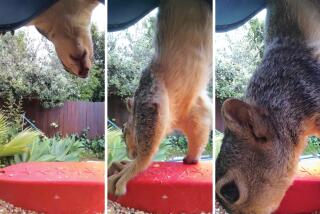Pursuing a Predator : Environment: Twenty-one red foxes have been trapped and removed from Ballona Wetlands, but some experts think that the problem has not been solved.
- Share via
PLAYA DEL REY — Ballona wetland birds, biologists and environmentalists are breathing a collective sigh of relief these days. The non-native red fox, it appears, is almost completely out of the henhouse.
Trappers hired by Maguire Thomas Partners, the development company that owns the 261 acres of wetlands between Marina del Rey and Westchester, successfully removed 21 foxes from Aug. 28 to Sept. 14, according to Mark Drew, a wildlife veterinarian for the California Department of Fish and Game. Nineteen red foxes, some dead, were sent to the department’s office in Rancho Cordova.
For the record:
12:00 a.m. Oct. 11, 1992 For the Record
Los Angeles Times Sunday October 11, 1992 Home Edition Westside Part J Page 3 Column 1 Zones Desk 2 inches; 54 words Type of Material: Correction
Fox trapping--A story on Thursday incorrectly stated that Dr. Richard Golightly, head of Humboldt State University’s Wildlife Management Department, estimated that there are still 20 to 60 red foxes in the Ballona Wetlands. Golightly’s estimate was for the original fox population, before trapping began. Twenty-eight foxes are known to have been killed by cars or removed so far.
Six of the 19 foxes were examined, neutered and sent on to new homes at Humboldt State University, where they will be a part of a non-invasive behavioral research program, Drew said. The university is waiting for two more healthy foxes from the wetlands to complete the eight requested for its study.
Drew said one fox was euthanized by the Department of Fish and Game because it was blind from cataracts.
Twelve foxes arrived dead, Drew said, and will be sent to Humboldt for necropsies and other analyses. In accounting for the dead foxes, Nelson Rising, senior partner at Maguire Thomas, said some were hit by cars and others were euthanized because of poor health or because they were older than what Humboldt University or a zoo in Carson City, Nev., would accept. Rising declined to say how many of the 12 were euthanized.
Two other foxes were trapped, examined and neutered before being sent to the Carson City zoo. Before Aug. 28, two foxes were euthanized, four were reportedly hit by cars and one died in a trap.
Environmentalists and biologists are praising the fox removal as a victory in their effort to restore the wetlands, increase nesting birds such as the endangered Belding savanna sparrows, and return mammal and reptile species that are in dramatic decline there.
Animal rights activists, who have been protesting the trapping since July, were surprised when told about the number of foxes that were euthanized.
Bill Dyer, a member of Last Chance for Animals said: “I understood that Maguire Thomas was really making a special effort to find homes for them. It raises a lot of questions about how they are being killed.”
Dyer and other activists also argue that the foxes are not a threat to the wetland ecosystem and do not need to be removed.
“We have never been convinced that the foxes have been predators of the birds,” Dyer said.
“Ridiculous,” said Dr. Richard Golightly, head of the Wildlife Management Department at Humboldt State University. Golightly, who has been studying red foxes all over Southern California for years, has a study on the subject coming out this month,
“We have tremendous claims to dispute their assertions that foxes don’t eat birds--a ludicrous claim,” said Golightly, who took scat samples from Ballona foxes. “We have gone through thousands and thousands of fox groups’ scats, and birds make up a considerable sample of scats.” He said 81% of fecal samples contained bird remains. Golightly called the foxes opportunistic eaters that will eat “mammals, eggshells, snakes, lizards, scorpions, butterflies and cockroaches.”
Golightly said a red fox in a “free-ranging situation” would probably consume about two-thirds of a pound of animal tissue a day.
“If you’ve got 40 hungry mouths to feed and you have 80 nesting birds, it doesn’t take foxes very long to consume them,” he said.
Daniel Kahane, an environmental education specialist for the National Audubon Society, uses the Ballona wetlands, the only major salt marsh left in the county, as a classroom to educate about 30,000 fourth- through sixth-graders from inner-city schools about ecosystems. He said he believes that the wetlands, the only major salt marsh left in the county, were harmed by the presence of the foxes.
“The Belding savanna sparrows were really at threat because the male sits in the pickleweed over the nest and guards against other sparrows by singing their territory. Of course, underneath is the female sparrow sitting on the nest of eggs,” Kahane explained. “It’s like advertising a free omelet to foxes.”
Kahane, who worked as an environmental consultant for a civil engineering firm before he joined the Audubon Society as an educator last year, walked through the wetlands Monday observing blue herons, black-bellied plovers, western meadowlarks, snowy egrets and belted kingfishers. He said the numbers are suspiciously low. Kahane added that the drought and the red fox wreaked havoc on native species and said he hopes that next spring’s breeding season will increase the population.
The last official census of the Belding savanna sparrow, a five-inch bird that has a thin, high-pitched call, counted nine breeding pairs in 1989. But recent unofficial reports put the number of pairs anywhere from one to eight.
Golightly and other biologists say the red fox problem will probably continue at the wetlands because of fox migration and a lack of conclusive information about the population. Golightly estimates that there are still 20 to 60 foxes at Ballona.
Rising said that although trappers have reported a sharp decline in fox activity since the trapping and removal began, they expect to continue to deal with the foxes. He said that two more fox relocation sites are being investigated but that homes at the zoo and Humboldt State took years to secure, and then only after much searching and wading through red tape.
If more homes cannot be found, Rising said any foxes trapped from now on will be euthanized to save the wetland from becoming a fox monoculture.






